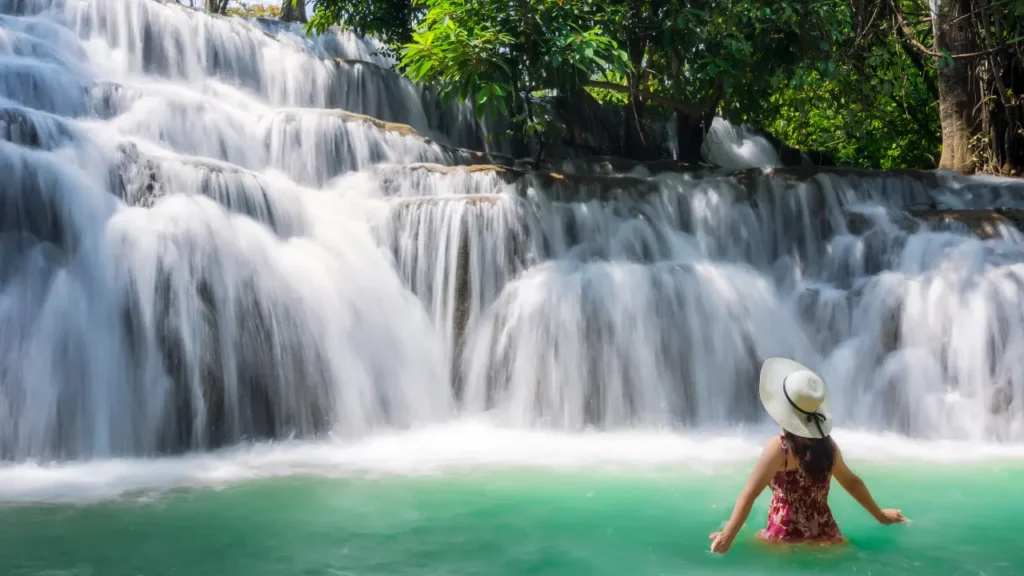Always observe posted safety signs and never swim alone at Bali waterfalls. Wear appropriate non-slip water shoes to maintain footing on slippery rocks.
Bali’s waterfalls offer a breathtaking plunge into nature’s grandeur. With lush landscapes and cascading waters, these natural beauties attract adventurers and relaxation-seekers alike.
Ensuring a memorable and injury-free experience requires adherence to safety measures. Strong currents, slippery surfaces, and hidden underwater obstacles pose risks that demand respect and caution.
Whether you’re a seasoned swimmer or a casual dipper, prioritizing safety can make all the difference in enjoying these aquatic marvels. As you prepare to immerse yourself in the serene waters of Bali’s falls, keep safety at the forefront of your aquatic adventure.
Table of Contents
ToggleUnderstanding Bali Waterfalls
Bali waterfalls offer a majestic experience for visitors. Each waterfall provides a unique adventure with their distinct characteristics. Known for their lush surroundings and serene ambiance, they seem like perfect spots for a refreshing swim. But there are critical safety measures one must adhere to so that the excitement doesn’t turn into misfortune.
Popular waterfalls like Tegenungan, Gitgit, and Sekumpul invite tourists year-round. These natural wonders boast crystal-clear waters and postcard-worthy backdrops, making them a must-visit for anyone traveling to Bali. Nonetheless, responsible enjoyment is paramount as the raw power of nature dictates respect.
| Waterfall Name | Characteristic | Swimming Safety Note |
|---|---|---|
| Tegenungan | Accessible & Family-Friendly | Watch for strong currents. |
| Gitgit | Tall & Majestic | Slippery rocks necessitate cautious movements. |
| Sekumpul | Secluded & Natural | Be mindful of flash floods during the rainy season. |
Swimming in Bali’s waterfalls should be a joyful and safe activity. Always stay within designated swimming zones, heed local advisories, and never swim alone. Recognizing the power of these natural phenomena is crucial for a secure and pleasant visit.
Assessing The Risks
Exploring Bali’s stunning waterfalls demands respect for the environment and an awareness of potential environmental hazards. Visitors should be mindful of the surrounding vegetation and wildlife, ensuring they do not disrupt the natural ecosystem. The underwater terrain can be unpredictable with hidden rocks or sudden depth changes, so it is vital to assess the water before entering.
Local weather conditions also play a crucial role in swimming safety. Sudden rain can cause flash flooding, turning a serene waterfall into a dangerous torrent. It is essential to check weather forecasts and seek advice from local guides to avoid such risks. Staying informed and prepared greatly enhances the safety of your Bali waterfall adventure.
Importance Of Local Knowledge
Engaging local guides is a critical step for ensuring safety when visiting Bali’s waterfalls. Experts in the area not only know the best routes to take, but they are also aware of any potential hazards that could arise from sudden weather changes or terrain difficulties. They can lead you to the most breathtaking spots while ensuring your journey stays within safety boundaries.
By understanding cultural practices, visitors show respect for local traditions and can avoid unintentionally disrespecting sacred sites. Many waterfalls in Bali hold spiritual significance, and being mindful of local customs can enhance the experience, making it both memorable and respectful. Following the guidelines laid out by those who hold these places dear is a mutual benefit.
Local safety recommendations should be adhered to without question. These may include advice on what to wear, what time of day is safest to swim, or areas to avoid due to slippery rocks or strong undercurrents. Heeding such advice not only ensures personal safety but also helps to preserve the natural beauty of the waterfalls for future visitors to enjoy.
Essential Safety Precautions
Wearing appropriate swimwear is essential for ensuring safety and comfort when exploring Bali’s breathtaking waterfalls. Choose swimwear that fits snugly to prevent it from getting caught on natural underwater obstacles. It’s crucial to select a fabric that resists damage from rough surfaces and can withstand the forces encountered in flowing water.
To enhance safety, using safety equipment such as water shoes for grip on slippery rocks, and a life jacket for those not confident in their swimming abilities is advisable. A reliable helmet can also protect against accidental bumps and falls.
Setting personal limits is a critical aspect of waterfall safety. Acknowledge your swimming proficiency and do not venture into deep water or strong currents beyond your comfort level. Stay alert to weather changes and know your exit points; sudden rain can rapidly change water conditions.

Waterfall Safety Techniques
Bali’s waterfalls are mesmerizing, but it is crucial to understand the water currents before you plunge in. The water can often be more powerful and unpredictable than it appears. Ensure to observe the direction and speed of the water and avoid areas that seem to have strong undercurrents or a turbulent flow.
Safe swimming techniques are vital to enjoying these natural wonders. Always enter the water slowly, testing for footing and depth. A useful strategy is to swim parallel to the shore when you’re caught in a current and yell for help if necessary while conserving energy.
It is imperative to identify potential hazards. Keep an eye out for slippery rocks, sudden drop-offs, and hidden obstacles underwater. Visitors should always check for warning signs and follow local guidelines, safeguarding against unforeseen dangers.
Emergency Preparedness
Understanding basic first aid is crucial for emergency preparedness while visiting Bali waterfalls. Accidents can happen, and knowing how to handle cuts, bruises, or more serious injuries is important for the safety of all visitors. Being knowledgeable about CPR and how to treat shock or hypothermia can be a life-saving skill.
Creating a safety plan before embarking on your adventure is another essential step. This should include having a route planned, understanding the terrain, and knowing where to find help if needed. Keeping an emergency kit with essential supplies such as water, food, a whistle, and a flashlight can aid in times of distress.
Seeking assistance when needed is a sign of good judgment. Visitors should not hesitate to call for help in case of an emergency. Alerting local authorities or reaching out to waterfall guides should be done promptly if someone is injured or if you find yourself in a risky situation. Always keep local emergency numbers handy and know the location of the nearest medical facility.
Cultivating Responsible Tourism
The preservation of Bali’s natural beauty and the well-being of its waterfalls heavily depend on the actions of tourists. The continual flow of visitors has a significant environmental impact, which can be mitigated by adopting eco-friendly practices.
Visitors should always strive to leave no trace behind, ensuring the sites remain pristine for future generations. This involves carrying out any waste, using biodegradable products, and staying on marked paths to avoid disrupting the local ecosystem.
Supporting sustainable tourism efforts is crucial in conserving Bali’s unique landscapes. Tourism can serve as a positive force, contributing to the protection of these natural treasures when managed responsibly. By participating in eco-tours and contributing to conservation initiatives, travelers can enhance the preservation and restoration of the area.
Tourism must also encompass the utmost respect for local communities and traditions. Bali’s waterfalls are not just tourist attractions but hold cultural significance for the people who live there.
Travelers are encouraged to engage with locals in a respectful and considerate manner, taking the time to learn about the cultural practices associated with the waterfalls. By doing so, visitors contribute to a positive tourism culture that values and protects Bali’s rich heritage.
Frequently Asked Questions For What Are The Swimming Safety Tips For Bali Waterfalls
What Are Essential Bali Waterfall Safety Tips?
Visiting Bali waterfalls requires caution. Always heed local advice, wear suitable footwear to prevent slips, avoid visiting during heavy rain which can lead to flash floods, and swim only in designated areas to ensure your safety amidst currents and rocks.
How Do I Avoid Bali Waterfall Accidents?
To avoid accidents at Bali waterfalls, it’s crucial to follow safety signs, stay on marked paths, and avoid climbing slippery rocks. Always travel with a companion and watch the weather, as conditions can change rapidly causing hazardous environments.
Can You Swim In Bali Waterfalls?
Yes, swimming is allowed in many Bali waterfalls but should be approached with care. To guarantee safety, only swim in designated areas, assess the water depth before entering, look out for strong undercurrents, and never dive headfirst into unfamiliar waters.
What Is The Best Time To Visit Bali Waterfalls?
The optimal time to visit Bali waterfalls is during the dry season, typically from April to October. During these months, the weather is more predictable and water levels are lower, reducing the risk of flash floods and ensuring better access to swimming areas.
Conclusion
Embracing these safety measures transforms your Bali waterfall adventure into an unforgettable experience. Prioritize your well-being, and the beauty of nature becomes a backdrop for cherished memories. Remember, protect yourself first, and the cascading waters will be a pleasure, not a peril.
Dive into Bali’s natural wonders with cautious enthusiasm, and let each splash be a story of secure, spirited exploration.



